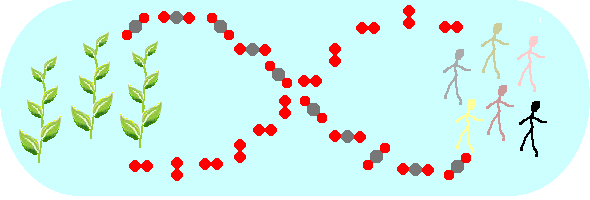Photosynthesis
Photosynthesis means "putting together with light," where photo stands for "light" and synthesis stands for "putting together."
It's a set of processes through which plants make food and produce oxygen, two things that are critical to our survival here on Earth. Without plant food and oxygen, we just couldn't be here. That's how much we depend on plants and the processes of photosynthesis. They are that important. So it might be good for us to know, at least in the most basic terms, how photosynthesis works. Here we'll show you the basics.
The basic processes
Plants contain in their leaves and stems a special molecule that's called chlorophyll. It's chlorohyll that gives leaves and stems their green color.
These chlorophyll molecules carry out the processes of photosynthesis within tiny food assembly "factories," called chloroplasts, just one of a number of different types of tiny organisms that, together, populate each of a plant's many cells.

These tiny food assembly factories take in two kinds molecules as raw material. They pull these molecules apart into the atoms of which they're made and, through a long string of processes which we will not spell out in detail here, eventually recombine those atoms to produce a food molecule and a bunch of molecules of pure oxygen. For chloroplasts to do all this work requires a good deal of energy. They get that energy from the sun, through tiny packets of light called photons which it showers down on us every day.
The two molecules the chloroplasts take in and pull apart are ones with which we are all very familiar. These are:
water, which is made up of a single atom of oxygen and two atoms of hydrogen: H-O-H
carbon dioxide, made up of a single atom of carbon and two atoms of oxygen: O-C-O
Plants get most of their water from the ground through their roots, and most of their carbon dioxide from the air though tiny pores in their leaves called stomata.

Within a chloroplast, two kinds of operation go on at the same time: disassembly and assembly. Carbon dioxide and water molecules are pulled apart and, in the blink of an eye, their parts are put back together in new combinations with other kinds of atoms. The final output of the string of processes involved in photosynthesis is, at the most basic level, a single food molecule — glucose, a plant sugar — and a bunch of 2-atom molecules of pure oxygen. That's what you see depicted to the right of the photosynthesis disassembly & assembly line in the picture above.
Look at how many molecules it took to make that single glucose molecule and the oxygen that is left over. In all, it took 12: 6 carbon dioxide and 6 water molecules. Photosynthesis is a major piece of work.
Food for plants. Food for us.
What happens with the new molecules photosynthesis produces? The plant stores the food molecule in its own cells. It exhales most of the oxygen into the air through the stomata, the same tiny leaf pores through which it had inhaled the carbon dioxide in the first place. Where we inhale and exhale through our mouths, plants do that through their leaves!
Plants use some of the food molecules they store for their own nurishment and growth. Fortunately for us, however, we also get to benefit from the chloroplasts' hard work. We harvest some varieties of plants for our own use as food. There are over 350,000 different species of plant in the world. We eat about 7,000 of those. So we eat about 1 of every 50 types of plants that exist today.
Reciprocity
Finally, it might be said that plants and animals are in a kind of partership in making our respective ways on this planet. We've noted how plants breathe in carbon dioxide and breathe out oxygen. We do just the opposite. We breath in oxygen and breath out carbon dioxide, the gas on which plants so much depend. To a very large degree, then, each of us supplies the other the most important part of the air we each breathe.



